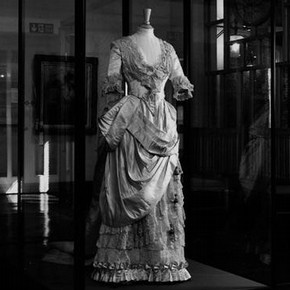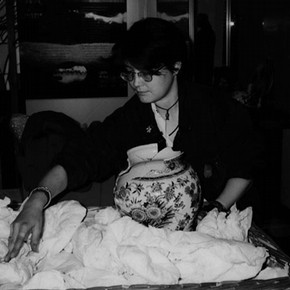Conservation Journal
April 1997 Issue 23
Exhibitions: How do they do it?

Figure 1. May Primrose wedding dress in its display case (Museum No. T428-1990). Photography by V&A Photographic Studio. (click image for larger version)
Last year, I was given the rare opportunity of stepping into curator's shoes. I organised an exhibition - actually, a small display - but from my starting point of ignorance it might as well have been an all time blockbuster show! I have survived the experience with the highest regard for my colleagues in the collections who do this sort of thing on a regular basis and on a far larger scale. Also I have learned a number of things: you can't do anything in the V&A without the help and goodwill of a lot of people, big exhibitions get priority over everything else (our display coincided with William Morris) and in the end, it all miraculously comes together.
Each year, the graduating students of the Royal College of Art/Victoria and Albert Museum (RCA/V&A) Joint Course in Conservation have taken part in the annual RCA Degree Show. Unfortunately, the problems of borrowing and exhibiting museum objects in these surroundings for such a short period are enormous and so we were delighted when the Museum agreed to host a display of the students' work. This would be an opportunity to inform visitors about conservation in general, as well as about the Course and the significant contribution the students make to the Museum's work. It would also be educational: involving the students in all aspects of exhibition planning, including making decisions about what objects are suitable to go on exhibition, preparing objects for exhibition and transport, preparing the display cases, installing objects, checking light levels and monitoring the environment throughout the exhibition period.
The site we were given was by no means ideal; the gallery outside the Museum restaurant, where people queue, meet, wait, walk and sometimes look at whatever is on display. But, it had one major advantage which we were eager to exploit; the potential audience of visitors and museum employees. So, given our site and our audience we wanted our display to be eye-catching, informative and easy to understand in a short time. As a V&A display it had to look professional and at the same time it had to fulfil the purpose of a degree show - all six graduating students had to be represented equally. We wanted a lively and attractive design which would convey the idea that conservation was anything but stuffy. We commissioned a student from the Royal College of Art to design the graphic elements, but the most difficult part of the project was writing the text. There was so much to say about the field of conservation, the Department, the Course, our approach, the process of conserving an object, the objects themselves, the students and all on six panels.
As far as objects were concerned the star of the show was a splendid nineteenth century wedding dress (Figure 1). By far my most nerve wracking task was commissioning the design and construction of a display case large enough to hold the dummy and fully extended train. This brought me up against the conflict between what, as a conservator, I felt I ought to do and what would actually be possible on a shoestring budget. Conservation specifications for display cases are achievable at a cost. Other sources of anxiety were the environmental conditions: we expected the temperature and relative humidity to fluctuate considerably in the summer months. Luckily, the fluctuations in relative humidity were buffered sufficiently by our display cases. In the end, we were happy with the achieved compromise, between the ideal and any potential risk to the objects (conservation ethics at work!). However, the pressure to meet a deadline made me aware of how conservation can at times be perceived as an obstacle.
Did we succeed in our aims?
-
Eye-catching? Yes, thanks to the splendid graphics by Amelia Noble;
-
Informative? Probably a little too much so. The real challenge is to keep the text to a minimum and to use diagrams and images as much as possible;
-
Easy to understand? No, not really. Again, this comes down to too much text;
-
Professional looking? Yes, thanks to the skills of the designer and the generosity of the firms who produced the panels and the display case for the wedding dress;
-
What about the students? The timing of the display meant that they had to produce the text and images for it, conserve their objects and write their major projects - all at the same time! They were terrific and I hope they feel the results were worth the effort we all put into this new enterprise.
Acknowledgements
The RCA/V&A Joint Course in Conservation would like to acknowledge with gratitude the financial support of the following for the RCA/V&A Conservation 1996 display: The Conservation Unit of the Museums & Galleries Commission, Merlin Display Contracts Limited, Genix Imaging Limited, Willard Developments Limited, Secol Limited, Conservation Resources (UK) Limited and Conservation by Design Limited. With special thanks to Amelia Noble.
Notes
A review of the display by Mary Brooks appeared in Conservation News 61, 1996, p71.
The next student display, RCA/V&A Conservation 1997, will be in the Restaurant Foyer at the V&A from 11 June to 25 August 1997.
April 1997 Issue 23
- Editorial - The Raphael Cartoons at the Victoria and Albert Museum
- The Prodigal Son: Examination and conservation of a Flemish cabinet on stand
- Traditional practices for the control of insects in India
- Conservation of the 'May Primrose' wedding dress
- Exhibitions: How do they do it?
- The Arundel Society - techniques in the art of copying
- A visit to Liverpool
- RCA/V&A Conservation Course Abstracts
- Printer Friendly Version
